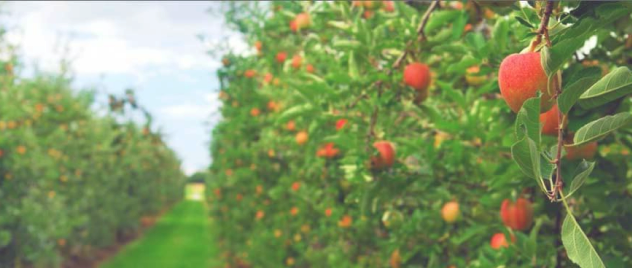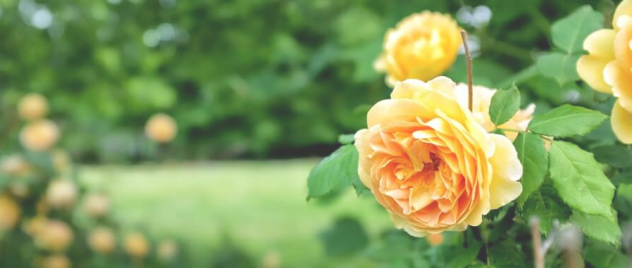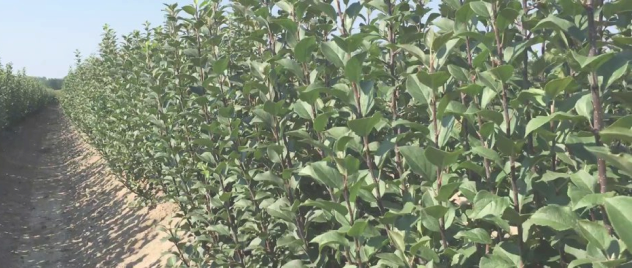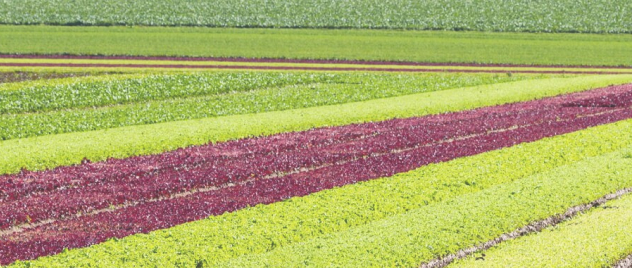PLUMS
Plum (Prunus domestica L.) is a woody plant of the Rosaceae family and it belongs to the genus of Prunus. Plum is a drupe fruit and they have a high nutritional value. Today there are over 2500 varieties of domestic plum cultivars and is a highly adaptable plant to altitude and soil type. In addition to fresh consumption, plums are also widely used in the processing industry for making juices, jams, dried plums, etc. Abundant in various nutrients, fruit sugars, acids, mineral salts, aromatic substances, vitamins, and other important ingredients. The most important vitamins in the plums are provitamin A, followed by vitamins C and B.
PLUM
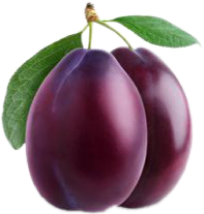
ROOTSTOCKS
PRUNUS CERASIFERA (PRUNUS MYROBALAN)
A seedling rootstock used for European plum and apricot production. Widely compatible with most cultivars. Suitable for various soil conditions. A semi-vigorous to a vigorous rootstock. Trellis is recommended for the first few years, but not necessary. The trees are hardy and vigorous, long-lived, and standard sized. Trees start bearing 4 to 5 years after planting.
TRAINING SYSTEMS
DWARF PYRAMID
The advantage of this system is a strong and elastic tree skeleton formed at the beginning of a central branch, and evenly arranged side-branches, while fully formed, this crown has no main leader. 1-year-old trees from the nursery are planted, and in spring are cut to the height of 80-100 cm from the ground. At the end of July, 3 strongest and evenly spaced young branches are picked and left to grow. Top one is chosen for a central leader, to extend the tree trunk, and two others to form side branches. The height difference between the side-branches is 30-40 cm. Mildly vigorous shoots on the trunk are left to grow while others are removed. Early in the spring of the following year, the top of the central extending branch is cut 80-100 cm counting from the highest young branch that has grown. Two of the young branches are left to form another level of side branches. Again, in July on the extending central branch 3 branches are picked, 1 for the extension of the central leader, and the second two for side branches maintaining the distance between them. To maintain the balance of growth the branches are controlled by bending, cutting, etc. The process is repeated in the 3rd and 4th years.
SLENDER SPINDLE
The height of the tree formed in this way is around 2.5-3.0m, and the main tree frame consists of the central leader. All secondary frame branches and fruit-bearing branches are directly connected to the main leader. Branches are formed without any specific order, and the number is different from tree to tree as young branches and every shoot that has medium vigour and right angle of growth is left to form a yielding branch. Nevertheless, the intention is to form a spiraling branch structure around the main leader at a distance of 15-25 cm. Branches that can not bend adequately, and that are too vigorous are cut to a 15 cm stump. The half-skeletal branches are 0.5 to 0.8 m in length depending on the row distance. These branches going from bottom to top form a pyramidal structure and smaller branches on the top have a more open-angle. It takes 4 years to fully form a tree in this system, and in this time the fruit-bearing is also forced. The slender spindle production process is the same as with other types of fruit.
See our full SELECTION of PLUM TREES we have in our offer
ČAČAK’S EARLY
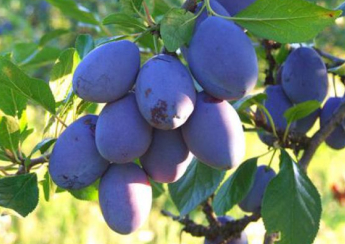
TREE:
Medium vigorous to a vigorous tree with pyramidal and sparse crown. An early bearer after planting. This variety is a regular and abundant yielder. It is flowering mid-early.
POLLINATORS:
Self-sterile. Suitable pollinators include Čačak’s Beauty, Čačak’s Best and Stanley.
FRUIT APPEARANCE:
Egg-shaped, somewhat elongated, with thin, purple to blue skin. The flesh is yellow, medium-firm, juicy, and sweet, with an exquisite taste.
FRUIT SIZE: Medium-large to large.
HARVEST:
Early. End of June to the beginning of July.
COMMERCIAL USE:
It is a very good yielder. Handles transport well. Consumed widely as a table fruit.
ČAČAK’S BEAUTY
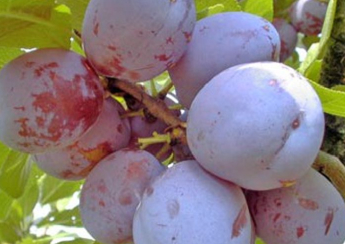
TREE:
A less to a medium vigorous tree with a pyramidal crown. The skeletal branches are strong and flexible. Starts yielding early, in the second or third year, with regular and abundant yields. It is flowering mid-early. Relatively resilient to drought.
POLLINATORS:
Self-fertile, but gives best results when planted near another variety.
FRUIT APPEARANCE:
Round to oval in shape, with a prominently visible seam that divides it into two equal halves. Thin, sturdy, dark blue skin. Firm, green to yellow flesh.
FRUIT SIZE: Medium-large.
HARVEST:
Mid-early, from end of July to the beginning of August.
COMMERCIAL USE:
Due to the low vigour, it is great for intense planting systems. Handles transport well. Suitable for fresh consumption as well as dried. Often used in the fruit processing industry.
ČAČAK’S BEST
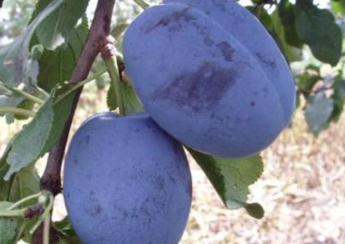
TREE:
A vigorous variety with a pyramidal, with a rather sparse crown. Regular, abundant, high potential crops. Flowering is mid-early.
POLLINATORS:
Suitable pollinating partners include varieties such as Čačak’s Beauty, Čačak’s Early and Čačak’s Native.
FRUIT APPEARANCE:
An oval, egg-shaped fruit. Dark blue, medium-thick skin with a greenish-yellow, very firm but juicy flesh. Sweet to sour in taste.
FRUIT SIZE: Large to very large.
HARVEST:
Mid-August.
COMMERCIAL USE:
Handles transport excellently. Suitable for fresh consumption and processing, drying, freezing, and brandy making.
ČAČAK’S NATIVE
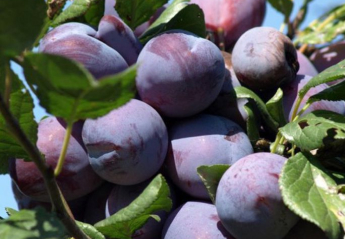
TREE:
A moderately vigorous tree with a loose pyramidal crown. This variety starts yielding early after planting and gives regular and heavy yields on 1-year branches. It is recommended to be pruned regularly. It is flowering mid-early.
POLLINATORS:
An outstandingly self-pollinating variety.
FRUIT APPEARANCE:
Elongated, egg-shaped fruit with a pointer top. Rich blue colored thin skin with a greenish-yellow flesh which is firm and crispy, yet juicy in texture. Aromatic, sweet to sour in taste.
FRUIT SIZE: Medium-large.
HARVEST:
Mid to late August.
COMMERCIAL USE:
Excellent yielder when maintained properly. Consumed fresh or dried, suitable for processing, jam, etc. Handles transport well.
STANLEY

TREE:
Medium vigorous with a relatively loose crown, round to pyramidal in shape, with strong and flexible branches. Stanley is an early, regular and heavy bearer. Stanley is a good choice for humid climates. Thrives best in sunny places and is easy to grow. It is flowering mid-early. Relatively resilient to drought.
POLLINATORS:
Self-fertile, but yields more abundantly if planted next to another variety. An excellent pollinator for other varieties.
FRUIT APPEARANCE:
Oval-shaped fruit. Dark blue to purple in color with a firm, juicy, greenish-golden flesh. Sweet, aromatic, rich flavor.
FRUIT SIZE: Medium-large.
HARVEST:
Late, in Autumn (usually second half of August, early September).
COMMERCIAL USE:
Excellent for fresh consumption, drying, canning, and preserving. Important variety in the plum growing industry. Handles transport well and it stores well.
RUTH GERSTETTER
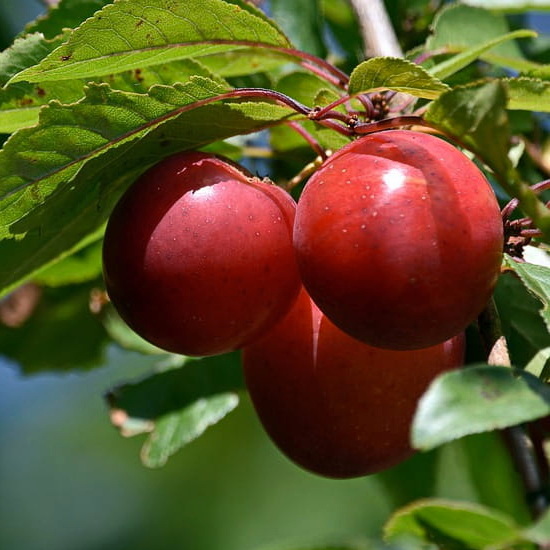
TREE:
The Ruth Gerstetter plum tree is a medium-sized tree with a spreading growth habit. It forms a well-shaped canopy with moderate vigor. It blooms early, typically in late March or early April, depending on the climate. Gives very good and regular yields.
POLLINATORS:
Ruth Gerstetter plum trees are self-fertile and do not require a specific pollinator. However, having other plum or pollinator-friendly fruit tree varieties nearby can improve fruit set and yield like the Stanely variety.
FRUIT APPEARANCE:
Ruth Gerstetter plums are medium to large-sized fruits with a rounded shape. The smooth and shiny skin has a vibrant reddish-purple color, often with a slight bluish bloom. The plums have juicy and succulent golden-yellow flesh that offers a delightful balance of sweetness and tartness. The flesh is smooth and firm, making it easy to bite into.
FRUIT SIZE:
Ruth Gerstetter plums are typically medium to large in size, depending on growing conditions.
HARVEST:
Ruth Gerstetter plums are usually ready for harvest typically in late June through the first part of July, depending on the specific growing region and climate.
COMMERCIAL USE:
Ruth Gerstetter plums are highly regarded for their excellent flavor and versatility. They are ideal for fresh consumption, as their juicy and sweet-tart taste is a true delight. These plums are also well-suited for commercial processing including jams, jellies, pies, and preserves. Their attractive appearance, rich flavor, and firm texture make them a sought-after choice in the market.

